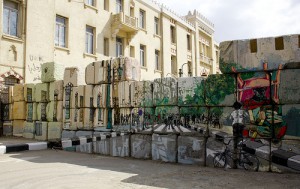 Over the past several months, in response to various outbreaks of fighting between protesters and security forces, the Egyptian military has constructed wall after wall in downtown Cairo. These walls are mostly situated to cordon off government buildings, creating a serious disruption in the flow of traffic and the integration of the city.
Over the past several months, in response to various outbreaks of fighting between protesters and security forces, the Egyptian military has constructed wall after wall in downtown Cairo. These walls are mostly situated to cordon off government buildings, creating a serious disruption in the flow of traffic and the integration of the city.
This ostentatious show of power and control led to a breathtaking graffiti project that has now completely taken over the concrete surfaces with murals that function to erase the walls by simply painting through them. Large murals using each wall as a single, unified canvas depict the continuing streets and other scenes that break out of and dismantle their physical barriers. These created-spaces are sometimes filled with children and rainbows, and other times with memorializing images of the battles that led to the wall’s construction. But whether playful or elegiac, such lively imagery stands in emphatic contrast to the barbed-wire barriers, armored vehicles, and scores of police that are an inescapable presence in the area.
It’s easy to get attached to these paintings. Some weeks ago, as a group of people set to work pulling down the wall on Qasr El Aini Street, one of the main arteries of Cairo traffic that since December has been completely blocked, there was understandably a vague sense of sadness about the disappearance of the artwork. But no one could be sad to see the wall gone. The paintings may be decoration, but their very existence, along with their particular form, serves to subvert looming symbols of oppression, and to assert control over the landscape of the city.
These are not the first walls to be presented as a barrier and subsequently transformed into a venue for art, and something Thierry Noir, one of the most noted painters of the Berlin wall, once wrote applies as well to Cairo as it did to Berlin. Noir states that to paint the wall is “to transform it, to make it ridiculous, to help destroy it.”
The paintings transform and expand both the walls and the spaces around them, overpowering even the barbed wire and the glum legions of police. A recent music video that incorporates the walls and the paintings does a very good job of ridiculing the offending structures.
Youssra El Hawary, dancing around with her irresistible accordion, sings of a man peeing on the wall. Her lyrics suggest to the ruling bodies of Egypt that they have done nothing more than build yet another edifice to be used as a venue for public urination. And what could be more humiliating?
Set in the faded colors of digitally-created nostalgia, the video presents the walls it ridicules in a romantic light — literally. The paintings that cover them are indeed beautiful, and they are beautifully captured in the music video. Though the video engages in a kind of twisted nostalgia for what amounts to great wounds in the fabric of downtown Cairo, it is defiant in the same playful way that the paintings themselves are defiant. Both the paintings and the video appropriate the walls and serve to tame them. Maybe neither project will contribute to the walls’ physical demise, but both create a sense of ownership of the city that, with a wink, undermines the central purpose of the walls, leaving them unable to intimidate, and rendered ridiculous.
This post may contain affiliate links.








